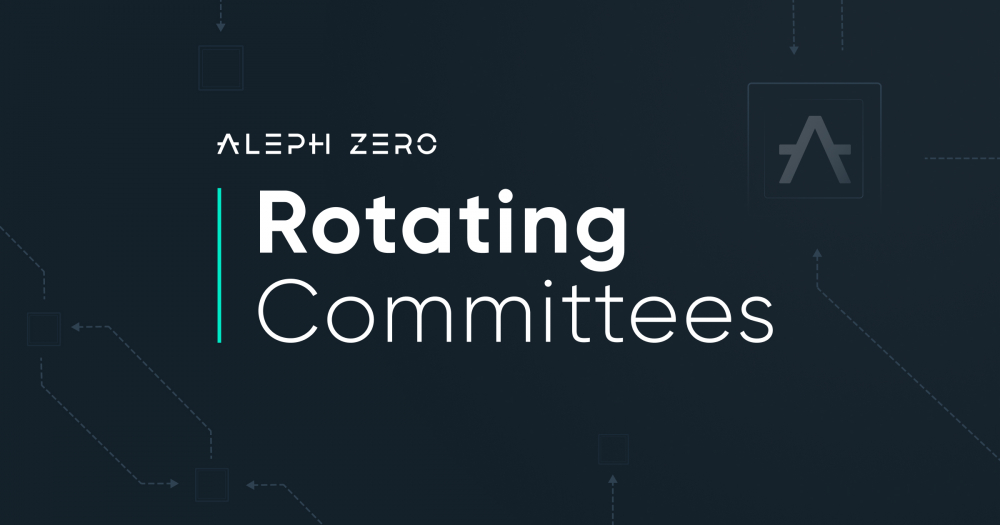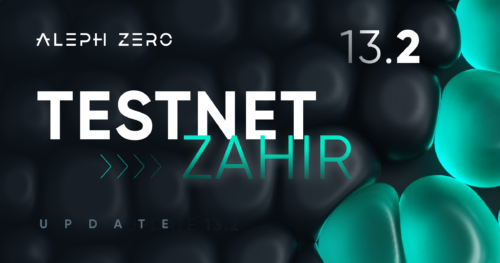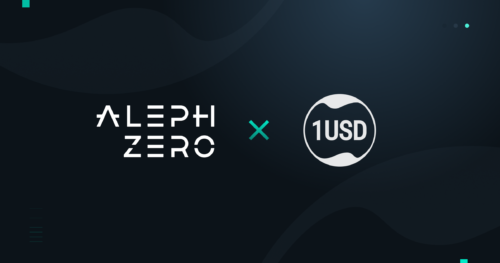Fundamentals: What’s the Deal With Rotating Committees?
Jun 17, 2022

Now that staking is live on the Aleph Zero blockchain it’s time to embark on the next step of our voyage into decentralizing Aleph Zero—the introduction of rotating committees.
One of the most prevalent trends we can observe in the blockchain industry is the growing popularity of consensus mechanisms based on Proof-of-Stake (PoS). There are a number of reasons for blockchains to get on board with this family of protocols, among which the most significant ones revolve around the issue of minimizing the ecological impact of blockchain networks, and the introduction of a more egalitarian decision-making process.
A crucial element in implementing a stronger democratic foundation for proof-of-stake blockchain protocols involves the element of rotating committees. Such solutions introduce an exciting new frontier in ensuring the decentralization of blockchain protocols by enabling a much bigger number of participating validators. The committee size typically stays the same, but its members change, so generally more validators can stay active (by being occasionally elected to the committee) and contribute to the security of the network.
The Logic Behind Rotating Committees
One of the mechanisms through which we can guarantee the decentralization of PoS protocols involves introducing transparent rules for getting into the committee. Potential validators are a select group of users who possess the amount of coins above a certain threshold (25 000 AZERO in the case of Aleph Zero) that they can stake on the network, and also fulfill the hardware requirements needed to run validator nodes that verify user transactions and blocks produced on the network. One of the key features of many PoS protocols, including Aleph Zero, is subjecting the third-party validators as well as the Aleph Zero Foundation nodes to election processes during which nominators will delegate their stake to their preferred validator, therefore giving them more sway over the direction of the protocol.
Such an election mechanism offers a degree of flexibility and beneficial volatility to the network by combating validator complacency, just as in democracies which demand that elected officials do the minimum that the voting public demands in order to stay in power from election cycle to election cycle. Additionally, the security of the blockchain is guaranteed through this “pay to play” system, as the stake that is locked by both nominators and validators disincentivizes malicious actions due to the financial risk involved. Committing financial malfeasance would result in severe losses to the bad actor as staked funds cannot be immediately withdrawn due to an un-bonding period (that lasts 14 days in the case of Aleph Zero) and will undoubtedly suffer from the price collapse that would accompany any wrongdoing. Throughout the brief, yet exciting history of blockchain technology, we’ve observed two main tools arise through which developers intended to achieve full decentralization. Let’s take a quick look at the two most popular mechanisms historically employed by blockchains to guarantee decentralization.
Proof-of-Work and Proof-of-Stake as Vehicles for Decentralization
Decentralization is a hot-button issue in the blockchain space as we’ve observed over the past few years the growing concern surrounding the purported decentralization of Proof-of-Work (PoW) consensus protocols. One of the drawbacks of PoW solutions is rooted in the mining process itself. This block validation solution empowers those who possess access to the specialized equipment necessary to conduct this operation and therefore are directly responsible for verifying the truthfulness of the network. This resulted in a scenario where a few large mining hubs are responsible for guaranteeing the veracity of their respective PoW blockchain, a solution that can hardly be called decentralized. It also demands users to form very strong trust assumptions regarding those who are validating transactions and deciding upon the future of the network. A scenario not unlike that which touches on centralized solutions.
One of the steps towards ensuring a significantly fairer decision-making process is offered through PoS protocols in which validators and nominators stake their tokens on the network thereby becoming co-responsible for the network’s future. The level of entry for these protocols is typically lower than with their PoW counterparts, as it generally takes a set number of tokens to start influencing the direction the blockchain is headed. These thresholds should usually be low enough to allow large swathes of potential users to get their foot on the ladder and become nominators. Once they become nominators, users can stake their tokens by taking part in validator elections and therefore influence the state of the network. For most blockchains employing a PoS architecture, the first step towards decentralization includes going through a phase in which a fixed committee is employed.
What Are Fixed Committees?
Fixed committees are solutions that employ a limited number of validators calling the shots. The security of the blockchain is dependent upon this pool of validators that decide upon everything from block production to the direction the network is headed. There are some advantages to this solution as a limited number of actors results in higher efficiency and ease of implementation. The drawbacks though are also significant, as such systems require very strong trust assumptions on part of the average users. Corruption and bribery can always potentially take root!
Additionally, certain attacks can be conducted by malicious actors that can quickly compromise the committee’s initial function. For instance, Denial-of-Service (DoS) attacks come to mind as one of the threats against fixed committees. Such an attack turns the committee “blind” as it will not be able to receive messages from its respective committee members, nor validate transactions. As we can see from this example, fixed committees don’t improve much upon centralized entities that face many of the same problems. This is a key argument for blockchain networks to pursue decentralized options and also the reason why Aleph Zero only employed a fixed committee architecture at the beginning of its journey. Initially, this fixed committee will consist of several Aleph Zero Foundation nodes validating the network’s block production and will be expanded upon through the addition of external validators.
Another crucial piece that limits the usability of fixed committees is that they do not push the democratically inclined agenda that stands at the heart of PoS systems. Nominators are shoehorned into “rigged” elections with limited choices on both validators and the direction the blockchain can take off in. The next step in the evolution of blockchain election mechanisms involves moving from a fixed committee to a rotating committee. This is our goal for Aleph Zero.
Aleph Zero’s Rotating Committee Mechanism
Besides the democratic arguments that speak in favor of a more fluid validator selection model, there are also technical arguments that reveal the benefits of rotating committees. In the model pursued by Aleph Zero, a fixed block committee will be chosen every 15 minutes that will validate transactions during this time. This results in a system in which during one era (24 hours), 96 unique committees are selected throughout the day resulting in a more diverse set of actors double-checking the consistency of the chain while also being responsible for appending new blocks.
Thanks to these mechanisms more validators can actively contribute to the security of the network.
Aleph Zero Reward Distribution Mechanism
Payout periods are divided into eras that are 24 hours long: 96 sessions, each 15 minutes long.
In order to become a nominator or validator, currently one needs to wait for the next era to start. We are working on lowering this delay to one session, i.e., max 15 minutes.
Payouts can be requested only after full-era completion up to the past 84 eras. What is also worth noting is the unbonding period – if one wants to get locked funds back after staking, then one needs to wait for 14 eras (days) to unlock the funds.
How are Rewards Calculated?
Era rewards
In each era we split rewards accordingly:
- 90% goes to nominators and validators,
- 10% goes to the treasury.
Inflation
We use uniform era payout, meaning that in each era, we reward validators and nominators a constant amount of tokens, which is approx 73,921 tokens, calculated as 0.9 * 30 mln tokens divided by 365.25 – the average number of days in the Julian calendar year.
Rewards key takes
- Validators and their nominator’s reward bucket are proportional to the validator’s uptime.
- Validators and all their nominator’s reward bucket is currently not proportional to the validator’s stake. This is a temporary situation and will change after the next update. The consequence is that it is more profitable to nominate validators that currently have fewer nominations in total.
- Rewards assigned to a particular validator, are split among the validator itself and its nominators proportionally to their stake.
The Disadvantages of Rotating Committees
One of the disadvantages of the rotating committees is the fact that in theory an adversary controlling significantly less than even 33% of the entire validator pool could have good luck and gain a majority in the elected committee. Fortunately, the chances of such an event are exponentially small in terms of the committee size, hence impossible in practice for bigger committees.
Aleph Zero Will Be Decentralized From the Network Validation Perspective
After the core team implements rotating committees on the mainnet, Aleph Zero will become decentralized from the network validation perspective. Achieving this milestone will signify the transferring of power from the Aleph Zero Foundation nodes to those run by the community. The Aleph Zero Foundation nodes won’t possess any privileges and will be subject to the same election process as everyone else. Moreover, the Foundation will try incentivizing the community-operated nodes by increasing its own commission, making it less attractive for nominators from the rewards standpoint.
Once the above happens, the future of the network will be firmly placed in the hands of the community members. The AZERO coin will be the tool through which important network decisions are conducted. We believe that the solution for decentralizing the Aleph Zero blockchain will result in a near-egalitarian experience for all parties involved without compromising on security and scalability.


